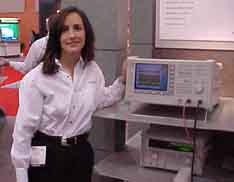Test Equipment Integration Leads to Cost Reductions for Wireless Labs
San Jose, CA—As wireless devices expand their spectrum, portable wireless device manufacturers must rely even more heavily on the performance of individual components, trusting that manufacturing specs meet design criteria. With that in mind, a number of test equipment suppliers are showing a greater range of products at this year's Wireless Symposium.
Citing a need for more integrated test equipment with greater data cross-referencing abilities, <%=company%> has drawn this editor's particular attention through the release of its Scorpion Vector Network Measurement System (VNMS).

According to company officials, the enhanced Scorpion line can be configured, at the customer's request, to check several wireless components within the RF application chain from passive devices to active, mixers and more. The enhanced VNMS system offers:
- 2-path, 3-port calibration that provides a less expensive alternative configuration for diplexer applications while maintaining measurement accuracy.
- a Power Sweep function that allows the analyzer to plot the characteristic of an amplifier and highlight its 1 dB compression point across frequency while permitting easily check and return characterization over power of the S-parameters as well as intermodulation and harmonic products.
- The ability to expand on third-order IMD measurements to the fifth-, seventh- and ninth-order IMD products and automatically calculate the corresponding third-order intercept.
- Frequency Translated Group Delay (FTGD) for mixer group delay measurements and a four channel overlay display capability with a SnP (S1P, S2P and S3P) output data format for interaction with simulation programs.
According to Anritsu officials, in addition to reducing the space required for test and calibration equipment, by combining multiple functionality into a single box, the Scorpion line can have the average cost of a single rack of test and calibration equipment.

Anritsu also debuted the ML2530A precision measurement receiver for calibrating signal sources and attenuators in a three step process that provides a frequency range of 100 kHz to 3 GHz, and power levels from +20 dBm down to –140 dBm. The system operates either in sweep monitor mode or manual tuning and uses a thermal sensor head that allows the ML2530A to achieve highly sensitive power at 1 Hz bandwidths.
Fore more information on the wide range of calibration and test equipment debuted at this year's Wireless Symposium, please refer to the Wireless Design Online Product Showcase today and each day throughout the week, as we bring you the latest news from the show floor.
